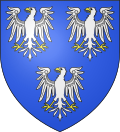You can help expand this article with text translated from the corresponding article in German. (April 2014)Click [show] for important translation instructions.
|
| Leiningen | |
|---|---|
| German noble family | |
 Arms of the Leiningen family | |
| Country | Holy Roman Empire |
| Place of origin | Leiningerland |
| Founded | 12th century |
| Founder | Emich II, Count of Leiningen |
| Current head | Andreas, Prince of Leiningen |
| Final ruler | Emich, Prince of Leiningen |
| Titles | |
| Deposition | 1918 |
| Website | https://fuerst-leiningen.de/ |

The House of Leiningen is the name of an old German noble family whose lands lay principally in Alsace, Lorraine, Saarland, Rhineland, and the Palatinate. Various branches of this family developed over the centuries and ruled counties with Imperial immediacy.
Contents
- Origins
- Line of Descent
- Earliest Counts
- Saarbrücken Line
- Leiningen-Dagsburg (First Line)
- Leiningen-Westerburg
- Leiningen-Leiningen
- Leiningen-Schaumburg
- Leiningen-Westerburg-Altleiningen
- Leiningen-Westerburg-Neuleiningen
- Leiningen-Hardenburg
- Leiningen-Dagsburg (Second Line)
- Further historical family seats
- See also
- Notes
- References
- External links


















